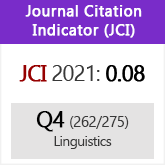Multiple bursts in non-native and native English: Evidence from twelve L1s
DOI:
https://doi.org/10.3989/loquens.2023.e100Keywords:
multiple bursts, voiceless plosives, voice onset time measurement, non-native English, native EnglishAbstract
Voiceless plosives are frequently produced with multiple bursts (MBs), a phenomenon that has substantial implications for voice onset time measurement (VOT) of these consonants. MBs have been noted in previous research, but have not been systematically quantified. The objective of this study was to analyze MBs in non-native English (with data from twelve first languages) and native English, and to discern the effect of MBs on VOT measurement. Further, the potential effects of place of articulation (PoA), gender, speech rate, and age on MBs were explored. Results showed that VOT measurement method in the presence of MBs had a significant effect on the VOT values obtained for the plosives. In addition, MBs were influenced to a large extent by PoA, but not by gender, speech rate, or age. Comparisons between non-native English and native English revealed some significant differences, but in both varieties the analyses of MBs showed overall similar tendencies.
Downloads
References
Asensi, L. Portolés, S., & del Río, A. (1997). Barra de explosión, VOT y frecuencia de las oclusivas sordas del castellano. Estudios de Fonética Experimental, IX, 221-242. /https://www.ub.edu/journalofexperimentalphonetics/pdf-articles/EFE-IX-LlAsensi_SPortoles_AdelRio-Barra_explosion_VOT_frecuencia_oclusivas_sordas.pdf
Barrera-Pardo, D. (2022). Measurement of the VOT of voiceless plosives: Multiple bursts in Western Andalusian Spanish. Estudios de Fonética Experimental, XXXI,81-95. https://www.ub.edu/journalofexperimentalphonetics/pdf-articles/XXXI-07-Barrera.pdf
Bóna, J., & Auszmann, A. (2014). Voice onset time in language acquisition: Data from Hungarian. In S. Fuchs, M. Grice, A. Hermes, L. Lancia, & D. Mücke (Eds.), Proceedings of the 10th International Seminar on Speech Production (ISSP) (pp. 41-44). Cologne, Germany. /http://real.mtak.hu/15397/1/BA_VOT.pdf
Brinca, L. Araújo, L., Nogueira, P., & Gil, C. (2016). Voice onset time characteristics of voiceless stops produced by children with European Portuguese as mother tongue. Ampersand, 3, 137-142. https://www.sciencedirect.com/science/article/pii/S2215039015300114 https://doi.org/10.1016/j.amper.2016.06.006
Cohen, J. (1988). Statistical power analysis for the behavioral sciences. 2nd ed. Lawrence Erlbaum.
Cohen, J. (1990). Things I have learned (so far). American Psychologist, 45(12), 1304-1312. https://psycnet.apa.org/record/1991-11596-001?doi=1 https://doi.org/10.1037/0003-066X.45.12.1304
Cumming, G. (2012). Understanding the new statistics: Effect sizes, confidence intervals, and meta-analysis. Routledge. https://doi.org/10.4324/9780203807002
Davis, K. (1994). Stop voicing in Hindi. Journal of Phonetics, 22, 177-193. https://www.sciencedirect.com/science/article/pii/S0095447019301925 https://doi.org/10.1016/S0095-4470(19)30192-5
Docherty, G. J. (1992). The timing of voicing in British English obstruents. Foris. https://doi.org/10.1515/9783110872637
Ethnologue. (2022). Available online at https://www.ethnologue.com/, Accessed on 2 February 2023.
Fischer, E., & Goberman, A. M. (2010). Voice onset time in Parkinson disease. Journal of Communication Disorders, 43(1), 21-34. https://doi.org/10.1016/j.jcomdis.2009.07.004 PMid:19717164
Flege, J. E. (1981). The phonological basis of foreign accent: A hypothesis. TESOL Quarterly, 15(4), 443-455. https://doi.org/10.2307/3586485
Foulkes, P., Docherty, G, & Jones, M. (2010). Analyzing stops. In M. Di Paolo, & M. Yaeger-Dror (Eds.), Sociophonetics: A student's guide (pp. 58-71). Routledge.
Gass, S., Loewen, S., & Plonsky, L. (2021). Coming of age: the past, present, and future of quantitative SLA research. Language Teaching, 54, 245-258. https://www.cambridge.org/core/journals/language-teaching/article/coming-of-age-the-past-present-and-future-of-quantitative-sla-research/B30BA387EDA5B60A07DBBBF03E4BC45C https://doi.org/10.1017/S0261444819000430
Gráczi, T. E., & Kohári, A. (2014). Multiple bursts in Hungarian voiceless plosives and VOT measurements. In S. Fuchs, M. Grice, A. Hermes, L. Lancia, & D. Mücke (Eds.), Proceedings of the 10th International Seminar on Speech Production (ISSP) (pp. 158-161). Cologne, Germany. /https://www.researchgate.net/profile/Anna-Kohari/publication/305635295_Multiple_bursts_in_Hungarian_voiceless_plosives_and_VOT_measurements/links/579648c508aed51475e54c81/Multiple-bursts-in-Hungarian-voiceless-plosives-and-VOT-measurements.pdf
Hayward, K. (2000). Experimental phonetics. Pearson Education.
Imbrie, A. K. K. (2005). Acoustical study of the development of stop consonants in children. [Doctoral dissertation]. Massachusetts Institute of Technology, United States of America. https://dspace.mit.edu/handle/1721.1/33072 https://doi.org/10.1121/1.4778198
Kaňok, M., & Novotný, M. (2019). Effect of age and gender on articulation of voiced and voiceless stop consonants in Czech. Lekar a Technika: Clinician and Technology, 49(3), 97-101. https://ojs.cvut.cz/ojs/index.php/CTJ/article/view/5957 https://doi.org/10.14311/CTJ.2019.3.05
Kazemzadeh, A., Tepperman, J., Silva, J., You, H., Lee, S., Alwan, A., & Narayanan, S. (2006). Automatic detection of voice onset time for use in pronunciation assessment. INTERSPEECH 2006, n.p. https://doi.org/10.21437/Interspeech.2006-249
Keating, P. A., Westbury, J. R., & Stevens, K. N. (1980). Mechanisms of stop-consonant release for different places of articulation. Journal of the Acoustical Society of America, 67, S93. https://doi.org/10.1121/1.2018489
Kopkalli-Yavuz, H., Mavis, I., & Akyldiz, D. (2011). Analysis of VOT in Turkish speakers with aphasia. Clinical Linguistics & Phonetics, 25(4), 287-301. https://doi.org/10.3109/02699206.2010.529541 PMid:21091206
Ladefoged, P. (2003). Phonetic data analysis: An introduction to fieldwork and instrumental techniques. Blackwell.
Ladefoged, P., & Johnson, K. (2015). A course in phonetics. 7th ed. Cengage Learning
Ladefoged, P., & Maddieson, I. (1996). The sounds of the world's languages. Blackwell.
Lavoie, L.M. (2001). Consonant strength: Phonological patterns and phonetic manifestations. Routledge. https://doi.org/10.4324/9780203826423
Lousada, M. Jesus, L.M.T., & Hall, A. (2010). Temporal acoustic correlates of the voicing contrast in European Portuguese stops. Journal of the International Phonetic Association, 40(3), 261-275. https://doi.org/10.1017/S0025100310000186
Maddieson, I. (1984). Patterns of sounds. Cambridge University Press. https://doi.org/10.1017/CBO9780511753459
Major, R. C. (2001). Foreign accent: The ontogeny and phylogeny of second language phonology. Lawrence Erlbaum. https://doi.org/10.4324/9781410604293
Michelon Melo, R., Bolli Mota, H., Lisbôa Mezzomo, C., de Castro Brasil, B., Lovatto, L, & Arzeno, L. (2014). Acoustic characterization of the voicing of stop phones in Brazilian Portuguese. Revista CEFAC, 16(2), 487-499. https://www.scielo.br/j/rcefac/a/ZB9NzFyfJxgHCpK7s44RSwf/abstract/?lang=en https://doi.org/10.1590/S1516-18462011005000143
Millasseau, J., Bruggeman, L., Yuen, I., & Demuth, K. (2019). Durational cues to place and voicing contrasts in Australian English word-initial stops. In S. Calhoun, P. Escudero, M. Tabain, & P. Warren (Eds.), Proceedings of the 19th International Congress of Phonetic Sciences (pp. 3759-3762). Canberra: Australasian Speech Science and Technology Association Inc. https://www.internationalphoneticassociation.org/icphs-proceedings/ICPhS2019/papers/ICPhS_3808.pdf
Moran, S., & McCloy, D. (2019). Phoible 2.0. Max Planck Institute for the Science of Human History. Available online at http://phoible.org, Accessed on 21 May 2023.
Novotný, M., Pospíšil, J, Čmejla, R., & Rusz, J. (2015). Automatic detection of voice onset time in dysarthric speech. In 2015 IEEE International Conference on Acoustics, Speech and Signal Processing (ICASSP) (pp. 4340-4344).IEEE. https://doi.org/10.1109/ICASSP.2015.7178790
Parveen, S., & Goberman, A.M. (2012). Presence of stop bursts and multiple bursts in younger and older adults. Asia Pacific Journal of Speech, Language, and Hearing, 15(4), 265-275. https://www.tandfonline.com/doi/abs/10.1179/136132812804731811 https://doi.org/10.1179/136132812804731811
Plauché, M. (2001). Acoustic cues in the directionality of stop consonant confusions [Doctoral dissertation]. University of California, Berkeley, United States of America. https://escholarship.org/uc/item/8hz6k4c2
Plonsky, L., & Oswald, F. L. (2014). How big is "big"? Interpreting effect sizes in L2 research. Language Learning, 64(4), 878-912. https://doi.org/10.1111/lang.12079
Repp, B.H., and Lin, H-B. (1989). Acoustic properties and perception of stop consonant release transients. Journal of the Acoustical Society of America, 85(1), 379-396. https://pubs.aip.org/asa/jasa/article-abstract/85/1/379/969397/Acoustic-properties-and-perception-of-stop?redirectedFrom=fulltext https://doi.org/10.1121/1.397689 PMid:2921420
Sirsa, H., & Redford, M.A. (2013). The effects of native language on Indian English sounds and timing patterns. Journal of Phonetics, 41, 393-406. https://www.sciencedirect.com/science/article/abs/pii/S0095447013000399 https://doi.org/10.1016/j.wocn.2013.07.004 PMid:24860200 PMCid:PMC4028080
Song, J. Y., Demuth, K., & Shattuck-Hufnagel, S. (2012). The development of acoustic cues to coda contrasts in young children learning American English. Journal of the Acoustical Society of America, 131(4), 3036-3050. https://pubs.aip.org/asa/jasa/article-abstract/131/4/3036/830852/The-development-of-acoustic-cues-to-coda-contrasts?redirectedFrom=fulltext https://doi.org/10.1121/1.3687467 PMid:22501078 PMCid:PMC3339504
Sönmez, K., Plauché, M., Shriberg, E., & Franco, H. (2000). Consonant discrimination in elicited and spontaneous speech: A case for signal-adaptive front ends in ASR. Sixth International Conference on Spoken Language Processing, ICSLP 2000 / INTERSPEECH 2000. Beijing, China. https://www.isca-speech.org/archive/pdfs/icslp_2000/sonmez00_icslp.pdf https://doi.org/10.21236/ADA630638
Sučková, M. (2020). First language attrition in voice onset times in Anglophone expatriates residing in the Czech Republic. Brno Studies in English, 46(2), 47-66. https://digilib.phil.muni.cz/en/handle/11222.digilib/143206 https://doi.org/10.5817/BSE2020-2-3
Torres, M. I., & Iparraguirre, P. (1996). Acoustic parameters for place of articulation identification and classification of Spanish unvoiced stops. Speech Communication, 18, 369-379. https://www.sciencedirect.com/science/article/abs/pii/0167639396000258 https://doi.org/10.1016/0167-6393(96)00025-8
Wang, Y-T., Kent, R. D., Duffy, J. R., Thomas, J. E., & Weismer, G. (2004). Alternating motion rate as an index of speech motor disorder in traumatic brain injury. Clinical Linguistics & Phonetics, 18(1), 57-84. https://doi.org/10.1080/02699200310001596160 PMid:15053268
Wayland, R. (2019). Phonetics: A practical introduction. Cambridge University Press. https://doi.org/10.1017/9781108289849
Weinberger, S. (2015).Speech Accent Archive. George Mason University. Retrieved from http://accent.gmu.edu
Whalen, D. H., DiCanio, C., & Dockum, R. (2022). Phonetic documentation in three collections: Topics and evolution. Journal of the Phonetic International Association, 52(1), 95-121. https://doi.org/10.1017/S0025100320000079 PMid:35400757 PMCid:PMC8992502
Yang, J. (2018). Development of stop consonants in three- to six-year-old Mandarin-speaking children. Journal of Child Language, 45, 1091-1115. https://doi.org/10.1017/S0305000918000090 PMid:29667563
Yanushevskaya, I., & Bunčić, D. (2015). Russian. Journal of the International Phonetic Association, 45(2), 221-228. https://doi.org/10.1017/S0025100314000395
Zampini, M. (2008). L2 speech production research. In J. H. E. & M. Zampini (Eds.), Phonology and second language acquisition (pp. 219-249). John Benjamins. https://doi.org/10.1075/sibil.36.11zam
Published
How to Cite
Issue
Section
License
Copyright (c) 2023 Consejo Superior de Investigaciones Científicas (CSIC)

This work is licensed under a Creative Commons Attribution 4.0 International License.
© CSIC. Manuscripts published in both the printed and online versions of this Journal are the property of Consejo Superior de Investigaciones Científicas, and quoting this source is a requirement for any partial or full reproduction.All contents of this electronic edition, except where otherwise noted, are distributed under a “Creative Commons Attribution 4.0 International” (CC BY 4.0) License. You may read here the basic information and the legal text of the license. The indication of the CC BY 4.0 License must be expressly stated in this way when necessary.
Self-archiving in repositories, personal webpages or similar, of any version other than the published by the Editor, is not allowed.















